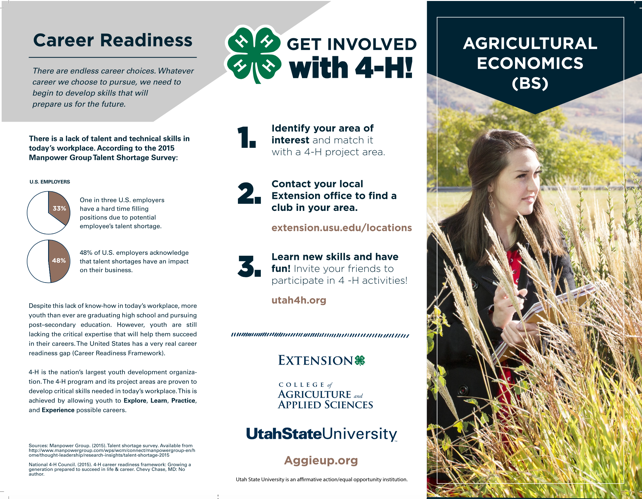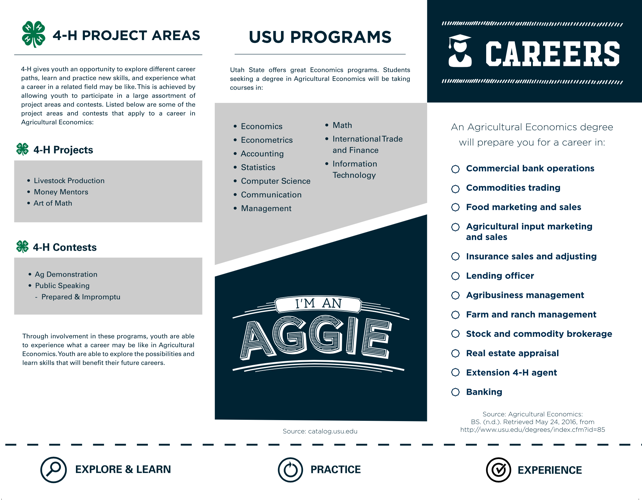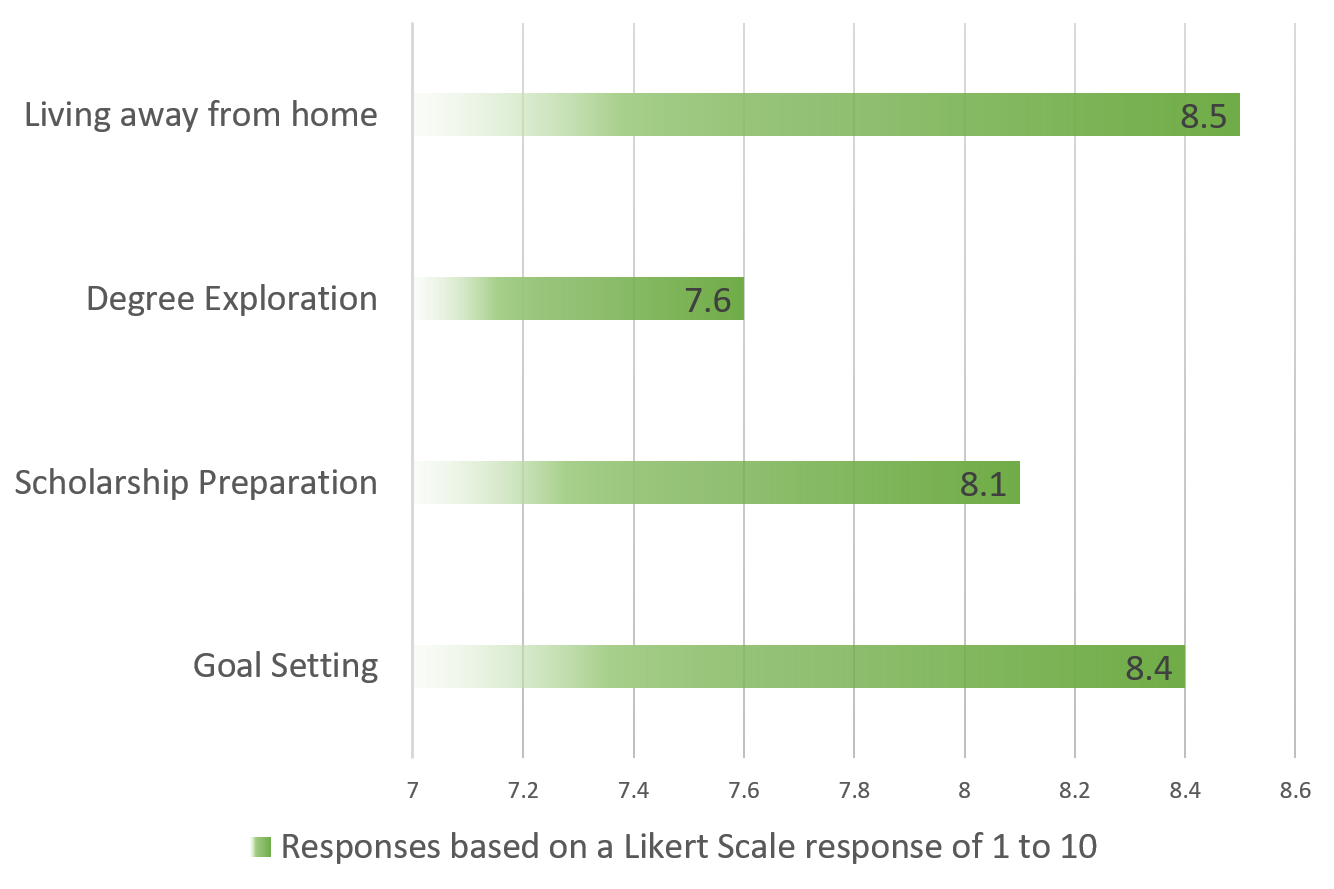Journal of the NACAA
ISSN 2158-9429
Volume 12, Issue 1 - June, 2019
Utah Agricultural 4-H College and Career Readiness Model
- Dallin, J., Extension Faculty-Box Elder County, Utah State University
Romney, K., Utah 4-H State Specialist , Utah State University
ABSTRACT
The Utah Agricultural 4-H Career Readiness model is based on a 2017 needs assessment of college preparedness among high school youth involved in a 4-H agricultural project area. This model simplifies the career readiness pathway for these youth, providing clear steps from 4-H club, to college, and eventually a career. Implementation at both state and county levels show that participating youth have improved their personal trajectory toward goal setting, scholarship preparation, degree exploration, and living away from home. Overall, findings suggest a strong need for statewide career readiness programming delivered via Extension.
INTRODUCTION
Today’s job market demands many skills that young people must prepare for to be successful in future careers. Extension can provide a bridge between high school and this preparation. According to Utah’s regents, “Utah’s workforce demands are rapidly changing and today’s jobs require an increasing amount of postsecondary education and training” (Utah State Board of Regents, 2016). There is a lack of technical skills in today’s workforce. In 2015, a talent survey found that one in three U.S. employers have a hard time filling positions due to potential employee’s talent shortage, and 48% of these employers acknowledge that talent shortages impact their business (Manpower Group, 2015). The Utah State Board of Regents issued this statement: “Utah is at a crossroads. It is in the midst of developing a strong technology and start-up sector, and continually ranks as the top state for business, career opportunity and economic competitiveness.” However, they recognize a gap in career preparation, maintaining that “In order for the state to maintain its upward trajectory, postsecondary education is critical” (Utah State Board of Regents, 2016). The Society for Human Resource Management (SHRM) also identified a very real workforce readiness gap on a national level. Its longitudinal studies found that the skills gap may be as much a result of changing jobs and the requirement for more productivity as the skill level of employees (Society for Human Resource Management, 2017).
Entering the workforce with soft skills and technical understandings of subjects related to personal interests is key to creating the job satisfaction and retention employers seek. Extension youth programs delivered through 4-H allow youth to experience hands-on activities related to their intrinsic interests, learning life skills that will launch them into successful careers (Lancaster et al., 2013). Proven to develop those critical skills needed in today’s workplace, 4-H allows youth to explore, learn, practice, and experience new opportunities found inherently in youth project areas (Lerner and Lerner, 2012). The objective of the Utah Agricultural 4-H College and Career Readiness model is to combine the enthusiasm cultivated in 4-H projects with the skills required by future education and careers.
METHODS
Faculty developed a research-based curriculum following a needs assessment of high school-aged 4-H youth, which was then tested during a state-wide 4-H event.
Needs Assessment
A needs assessment was conducted in 2017 to gather baseline information about college and career preparation from Utah 4-H agricultural club members. A sample of 30 high school-aged youth who were actively involved in 4-H completed anonymous surveys during a state-wide 4-H event. Demographic information was collected to determine participants’ 4-H involvement, rural or urban residence, years in 4-H, and age. Questions related to college and career readiness were derived from National 4-H Common Measures (National 4-H Council, 2014).
Curriculum Development and Testing
Curriculum was first developed by Extension faculty and then implemented by volunteers in agriculture-related 4-H clubs. The materials were created for use in 4-H meetings and packaged with the motto “Hard Tools to Teach Soft Skills.” Before launching, all of the curriculum and resources were tested in a pilot college and career readiness day camp held at Utah State University (USU) titled “4-H University.” During this first-year event, workshops were delivered by eight 4-H volunteers to 35 intermediate-aged 4-H youth representing every county in Utah. The volunteers used the Utah 4-H Career Readiness curriculum with minimal facilitation training. A post event survey was conducted to determine if the curriculum was effective. The curriculum includes the following activities and resources.
Club Meeting Warm-Ups. Adult mentors deliver short, 15-minute activities to start 4-H club meetings with these intentional, age appropriate college and career readiness lessons. Topics include:
- Setting goals
- Exploring degrees
- Preparing for scholarships
- Living away from home
First, leaders introduce the topic by asking youth to discuss their initial interpretations and general understandings. This is a great way to conduct an informal needs assessment in the club setting. Next, leaders facilitate one or two research-based, hands-on activities to meet objectives related to the topic. Lastly, leaders debrief with the group, talking about what students learned by participating in the Club Meeting Warm Up to identify new knowledge or skills gained. Leaders finish the activity by offering additional resources as follow-up activities for youth.
Nine club meeting warm-ups have been created, with three activities for each 4-H age group. Each activity is adaptable for any type of 4-H project area meeting. All of the club meeting warm ups follow the same template, and include research-based, peer-reviewed materials needed to facilitate the activities in ready-to-print attachments (Utah 4-H, 2018).
Career Readiness Pipeline Modules. These modules, as shown in Figures 1a and 1b, directly connect youth in their 4-H project areas to higher education and careers. The Career Readiness pipeline modules have been developed and peer-reviewed for all agriculturally based 4-H projects. They are available both online and in print form. Combined, they connect nearly 45 4-H agricultural experiences with over 35 college degrees and over 60 potential careers (Dallin, 2017).

Figure 1a. Career Readiness Pipeline Module pamphlet, page 1.

Figure 1b. Career Readiness Pipeline Module pamphlet, page 2.
Online Resources. The curriculum includes self-guided education and career exploration experiences. As part of the 4-H experience and to elicit interest in post-secondary education, youth are directed to a University database (Figure 2) that can help students identify degrees, areas of interest, and potential careers by simply entering a search word related to their interests in 4-H.

Figure 2. Utah State University degree and career database.
RESULTS
Needs Assessment
While 4-Hers answered an average of 4 on a 5-point Likert scale when asked if they would like to seek a career related to their 4-H project area, they also responded an average of 2.8 when asked if they learned about their personal fit with higher education. Their responses dropped further to 2.0 when asked if they learned about the first steps toward attending college (Table 1). These preliminary results clearly indicate that Utah 4-H programming needs to emphasize college readiness when implementing the curriculum.
Table 1. Needs assessment of high school-aged 4-H participants, 2017. Responses based on a Likert Scale from 1–5, where 5 = "Yes, definitely" and 1 = "Not at all".
|
Question |
Average Responses |
|
Would you like to seek a career related to your 4-H project area? |
4 |
|
During your time in 4-H, have you learned about your personal fit with higher education? |
2.8 |
|
During your time in 4-H, have you learned about the first steps toward attending college? |
2 |
|
During your time in 4-H, have you ever toured a college? |
2.5 |
|
During your time in 4-H, did you research colleges? |
3 |
|
Do you believe you can earn a college degree related to your 4-H project area that will lead to a career? |
3.4 |
Curriculum Development and Testing
Survey results following curriculum testing revealed that youth rated the 4-H College and Career Readiness curriculum an overall 8 out of 10 (Figure 3). Thirty-nine youth responded to the survey; when asked if they would recommend these materials to a friend, 31 responded "yes"; 8 said "maybe"; and none said "no". These results helped prove that those in attendance found enough value in the program to recommend it to others. In addition to recommendation questions, the youth were asked if they had plans to attend USU. Of the 39 responders, 14 said they would be attending USU, 25 said maybe, and 0 planned not to attend USU.

|
Figure 3. Results of surveyed youth regarding College and Career Readiness curriculum. |
Qualitative data were also collected by asking youth to describe what they had learned. Responses included the following:
- “Goals are important. They're your plan for the future and your map for the road ahead.”
- “I learned about different college degrees, and that I want to get lots of stackable scholarships.”
- “There are so many scholarships out there, so many opportunities you just have to reach out and grasp them.”
- “I learned that college isn't that scary after all.”
DISCUSSION
While 4-H provides youth the infrastructure and opportunity to learn critical career readiness skills, a 2017 needs assessment of 30 high school-aged youth who are actively involved in 4-H showed a lack of direct college preparation during their 4-H club meetings. Our research indicates that the Utah Agricultural 4-H College and Career Readiness model can successfully leverage the resources found in 4-H agricultural clubs to prepare youth for the future. Based on these findings, Extension professionals who are interested in providing college and career readiness education should consider the following:
- Adapt a uniform Extension-wide template.
- Ask campus faculty to help develop youth appropriate experiences related to their expertise.
- Partner with university specialists to provide the most accurate degrees related to the 4-H project interests.
- Work closely with university recruitment and outreach teams to best showcase available options.
- Connect 4-H project areas and career opportunities by showcasing real world job availability, after completing secondary education.
CONCLUSION
As the workforce readiness gap in America continues to expand, 4-H programming can close the gap from the skills learned in traditional agricultural 4-H club meetings to practical skills required to be a contributing member of society. The Utah 4-H College and Career Readiness Curriculum model simply defines the “how-to” in turning 4-H agricultural project areas into a clear pathway toward future success. The curriculum continues to grow in popularity as many campus faculty members partner with future 4-H youth career readiness experiences. Parents are understanding the benefits of career readiness curriculum, and are using the resources to improve their child’s future. Youth also see the value in connecting their current interests with future degrees and careers. Through the Utah Agricultural Career Readiness model, industry talent shortages in the workplace can be minimized through the model’s positive and practical youth development lessons. This model gives 4-H youth, parents, 4-H volunteers, and local teachers in Utah communities the “hard tools to teach soft skills” that will equip youth with excitement about a college degree and eventually a career.
The Utah Agricultural 4-H College and Career Readiness model addresses a serious need and provides the tools necessary to bridge the gap between youth experiences and future career opportunities. This adaptable model simplifies the career readiness pathway for youth to seek an education at a land-grant university and achieve their professional goals related to their current interests. The resources developed to create college and career readiness experiences can be adopted by any state to fit any agriculturally based 4-H project.
REFERENCES
Dallin, J. (2017). Utah 4-H Career Readiness Modules. Retrieved from https://digitalcommons.usu.edu/extension-2019
Lancaster, K., Knobloch, N., Jones, A., and Brady, B. (2013). Youth motivation to participate in animal science-related career development events. Journal of Extension 51(2). Retrieved from https://www.joe.org/joe/2013april/rb2.php.
Lerner, R. M., and Lerner, J. V. (2012). The positive development of youth. Report of the findings from the First Eight Years of the 4-H Study of Positive Youth Development, 1(1), v-vi. Tufts University.
Manpower Group (2015). Talent shortage survey. Retrieved from http://www.manpowergroup.com/wps/wcm/connect/manpowergroup-en/home/thought-leadership/research-insights/talent-shortage-2015
National 4-H Council (2014). Common Measures. Retrieved from https://4-h.org/professionals/common-measures/#!common-measures-1-0
Society for Human Resource Management (2017). Findings from SHRM’s national study of employers. Retrieved from https://www.shrm.org/hr-today/trends-and-forecasting/research-and-surveys/Documents/National Study of Employers (NSE) - Flier.pdf
Utah 4-H (2018). Club Meeting Warm Ups. Retrieved from https://utah4h.org/projects/leadership/careerreadiness/index
Utah State Board of Education. (2018). Data and Statistics. Retrieved from https://www.schools.utah.gov/data/reports?mid=1424&tid=5
Utah State Board of Regents. (2016). Utah: A State of Opportunity; Utah State Board of Regents Strategic Plan 2025. Retrieved from https://higheredutah.org/pdf/agendas/20160122/TABCC2016Jan.pdf
